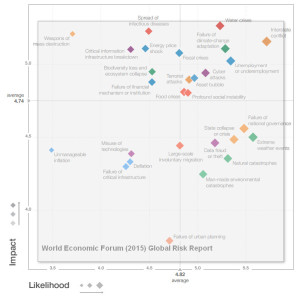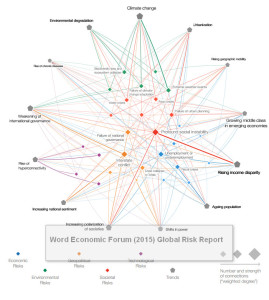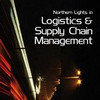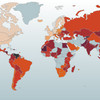 The World Economic Forum Global Risks Reports. I first came across them in 2008, when the hyperoptimisation of supply chains was a major issue, particularly, if coupled with a potential economic downturn. This was again highlighted in 2011, in the Supply Chain and Transport Risk Initiative, bringing together a range of leading experts to explore the most critical threats facing supply chain and transport networks. And now, in 2015, supply chains are again part of the global risk picture. This time, supply chains are at risk for getting too lean, highly effective, but also highly vulnerable.
The World Economic Forum Global Risks Reports. I first came across them in 2008, when the hyperoptimisation of supply chains was a major issue, particularly, if coupled with a potential economic downturn. This was again highlighted in 2011, in the Supply Chain and Transport Risk Initiative, bringing together a range of leading experts to explore the most critical threats facing supply chain and transport networks. And now, in 2015, supply chains are again part of the global risk picture. This time, supply chains are at risk for getting too lean, highly effective, but also highly vulnerable.
Lean supply chains = risky supply chains?
The Global Risk Report 2015 does not spend much ink on supply supply chains specifically, but the make the case for supply chain risks being interwoven with many other risks that in turn make supply chains vulnerable, and vice versa:
The far-reaching global supply chains set up by multinational corporations are more efficient, but the complexity and fragility of their interlinkages make them vulnerable to systemic risks, causing major disruptions. These comprise natural disasters, including those related to climate change; global or regional pandemics; geopolitical instability, such as conflicts, disruptions of critical sea lines of communication and other trade routes; terrorism; large-scale failures in logistics; unstable energy prices and supply; and surges in protectionism leading to export/import restrictions.
This reminds me of a post I made in 2009 where I reflected on the upsides and downsides of lean supply chains, based on a couple of articles I had read, and my conclusion was quite simple:
Is lean logistics the same as risky logistics? No, lean does not necessarily make you more vulnerable or less robust towards supply chain disruptions. Lean implies agile, and agile is what is needed to overcome supply chain disruptions.
The only problem, and the Global Risk report 2015 highlights this, is that world is no longer peaceful and quite for the most, it’s a rather unstable place with an uncertain future.
Global risk at a glance
At the heart of the Global Risk report 2015 is the overall risk picture. The Global Risks Landscape, a map of the most likely and impactful global risks, puts forward that, 25 years after the fall of the Berlin Wall, “interstate conflict” is once again a foremost concern. For those of us who have lived long enough to see and feel the rise and fall of the Cold War, that is not the 2015 world we expected in the early 1990s.
In 2015, on one hand, the most likely risks are Interstate conflict, Failure of national governance, State collapse or crisis, along with Failure of climate change adaptation and Extreme weather events. On the other hand, the most average risks, i.e. what the respondents fear most, are Food crisis and Profound social instability, along with Large-scale involuntary migration, the latter making much of the news in Europe this summer.
An interesting feature of the 2015 report is what trends that contribute to what risks:
It is clear that Profound social instability is THE risk that is driven by a number of trends, alongside Interstate conflict and Failure of national governance.
Looking at how risks are interconnected, a similar picture emerges:
Again, Profound social instability, Interstate conflict and Failure of national governance are at the heart of all other risks.
Conclusion
In summary, the Global Risk report 2015 highlights and reflects upon a wide range of cross-cutting challenges that can threaten social stability. These risks are additionally aggravated by the legacy of the global economic crisis in the form of strained public finances and persistent unemployment. So basically, things have not improved since the inception of the Global Risk Reports in 2005, they have in fact turned worse. Local risks have now gone global.
Related links
- weforum.org: Global Risk Report 2015
Related posts
- husdal.com: Global Risks 2008 – Supply Chain Risk
- husdal.com: Supply Chain and Transport Risk Initiative
- husdal.com: Lean logistics = Risky Logistics















